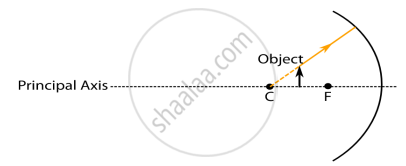Advertisements
Advertisements
प्रश्न
Which type of mirror is used in the following?
Shaving mirror
उत्तर
Concave mirror
APPEARS IN
संबंधित प्रश्न
If the image formed by a mirror for all positions of the object placed in front of it is always erect and diminished, what type of mirror is it? Draw a ray diagram to justify your answer. Where and why do we generally use this type of mirror?
Draw a ray diagram to show the path of the refracted ray in each of the following cases:-
A ray of light incident on a concave lens is
(i) passing through its optical centre.
(ii) parallel to its principal axis.
(iii) directed towards its principal focus.
A student has obtained the image of a distant object with a concave mirror to determine its focal length. If he has selected a well-illuminated red building as object, which of the following correctly describes the features of the image formed?
(A) Virtual, inverted and diminished image in red shade
(B) Real, erect and diminished image in pink shade
(C) Real, inverted and diminished image in red shade
(D) Virtual, erect and enlarged image in red shade
The radius of curvature of a spherical mirror is 20 cm. What is its focal length?
An object is placed at a distance of 12 cm in front of a concave mirror of radius of curvature 30 cm. List four characteristics of the image formed by the mirror.
Draw a ray diagram showing how a concave mirror can be used to produce a real, inverted and diminished image of an object.
What kind of mirror can have a focal length of, −20 cm?
A concave mirror produces three times enlarged virtual image of an object placed at 10 cm in front of it. Calculate the radius of curvature of the mirror.
An object is placed just outside the principal focus of concave mirror. Draw a ray diagram to show how the image is formed, and describe its size, position and nature.
At what distance from a concave mirror of focal length 10 cm should an object be placed so that:
its virtual image is formed 20 cm from the mirror?
An object is placed 15 cm from (a) a converging mirror, and (b) a diverging mirror, of radius of curvature 20 cm. Calculate the image position and magnification in each case.
To construct ray diagram we use two light rays which are so chosen that it is easy to know their directions after reflection from the mirror. List these two rays and state the path of these rays after reflection. Use these rays to locate the image of an object placed between centre of curvature and focus of a concave mirror.
A student obtained a sharp inverted image of a distant tree on a screen placed in front of the concave mirror. He then removed the screen and tried to look into the mirror. He would now see
(A) a very blurred image on the wall opposite to the mirror
(B) an erect and magnified image of the tree in the mirror
(C) no image as the screen has been removed
(D) a highly diminished inverted image of the tree at the focus of the mirror.
List four characteristics of the image formed by a concave mirror of focal length 40 cm when the object is placed in front of it at a distance of 20 cm from its pole.

While looking at the above diagram, Nalini concluded the following.
- the image of the object will be a virtual one.
- the reflected ray will travel along the same path as the incident ray but in opposite direction.
- the image of the object will be inverted.
- this is a concave mirror and hence the focal length will be negative.
Which one of the above statements are correct?
The concave reflecting surface of a torch got rusted. What effect would this have on the beam of light from the torch?
The ENT doctor uses a ______.
______ mirrors make things look larger when objects are placed close to them.
To obtain an image twice the size of the object, between which two points related to a concave mirror should an object be placed?
